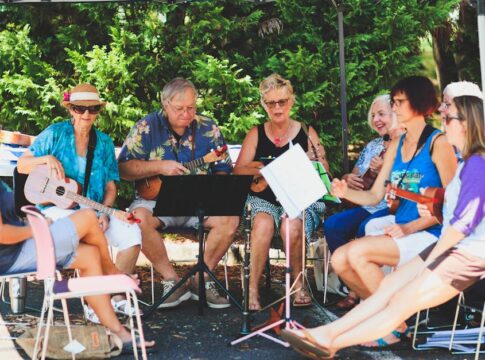⏱️ 5 min read
In the quiet town of Halberstadt, Germany, inside the medieval St. Burchardi church, an extraordinary musical performance has been unfolding since September 5, 2001. This isn’t your typical concert—it’s a radical reinterpretation of composer John Cage’s avant-garde piece “ORGAN²/ASLSP (As Slow as Possible)” that will continue for 639 years, finally concluding in the year 2640. This ambitious project represents one of the most extreme experiments in musical endurance and philosophical contemplation ever undertaken.
The Vision Behind the World’s Longest Concert
John Cage, the revolutionary American composer known for pushing the boundaries of what music could be, created “ORGAN²/ASLSP” in 1987, originally for piano. He later adapted it for organ in 1989. The piece’s title provides the only instruction: play it “as slow as possible.” While typical performances of this composition last between 20 and 70 minutes, the Halberstadt project takes this directive to its ultimate extreme.
The decision to perform the piece over 639 years wasn’t arbitrary. Organizers chose this duration to commemorate the 639th anniversary of the church’s organ, which was built in 1361. This historical connection adds layers of meaning to an already profound artistic statement about time, patience, and the nature of musical experience.
How the Performance Actually Works
The mechanics of this centuries-long performance are as fascinating as the concept itself. A specially constructed organ in St. Burchardi church plays the notes continuously using an automated system. Weights hold down the organ keys, and an electric blower provides constant air pressure to sustain each note for months or even years at a time.
The performance began with a 17-month pause—complete silence—as Cage’s composition opens with a rest. The first chord wasn’t heard until February 5, 2003. Since then, chord changes have occurred at irregular intervals, sometimes separated by months or years. Each change has become a significant event, drawing visitors and music enthusiasts from around the world to witness these rare moments of transition.
The Philosophy of Extreme Duration
This performance challenges fundamental assumptions about music, time, and human perception. In our age of instant gratification and decreasing attention spans, a 639-year musical piece serves as a powerful counterpoint. It forces us to reconsider our relationship with time and asks profound questions about the purpose and meaning of art that extends far beyond individual human lifespans.
The project embodies several key philosophical concepts:
- The impermanence of human life contrasted with the continuity of artistic expression
- The communal nature of experiencing art across generations
- The meditation on sound, silence, and the spaces between notes
- The questioning of whether music requires an audience to exist
John Cage’s Revolutionary Musical Philosophy
Understanding this performance requires familiarity with John Cage’s broader artistic philosophy. Cage believed that music existed everywhere—in ambient sounds, in silence, and in the spaces between intentional notes. His most famous work, “4’33”,” consists of four minutes and thirty-three seconds of deliberate silence, during which the “music” consists of whatever ambient sounds occur in the performance space.
Cage was deeply influenced by Zen Buddhism and embraced concepts of chance, indeterminacy, and the acceptance of whatever sounds emerge. The Halberstadt performance of “ORGAN²/ASLSP” extends these ideas to their logical extreme, creating a sonic meditation that spans centuries and invites contemplation on the nature of existence itself.
Notable Chord Changes and Public Events
Despite the glacial pace of the performance, chord changes have become significant cultural events. The most recent note change occurred on February 5, 2022, when visitors gathered to witness the transition. These occasions have transformed from simple musical events into almost ceremonial gatherings where people from diverse backgrounds come together to mark a moment in an artwork that dwarfs individual human timescales.
The church has established a foundation to maintain the performance and ensure its continuation through the centuries. This organizational structure acknowledges the practical reality that dozens of generations will need to commit to this project before its completion in 2640.
The Impact on Contemporary Music and Art
The Halberstadt performance has sparked conversations throughout the art world about duration, patience, and the purpose of artistic expression. It has inspired similar long-duration works and prompted artists to reconsider the temporal dimensions of their creations. In a digital age where content is consumed in seconds, this project stands as a monument to sustained attention and long-term commitment.
Music theorists and philosophers continue to debate whether this constitutes a “performance” in any traditional sense, whether the artwork exists in the sound itself or in the conceptual framework, and what it means for art to exist primarily as an idea rather than an experience any single person can fully appreciate.
Visiting the Performance
The St. Burchardi church welcomes visitors who wish to experience this unique performance. The church has become something of a pilgrimage site for those interested in experimental music, philosophy, and pushing the boundaries of artistic expression. Visitors can hear the sustained tones resonating through the medieval space, creating an atmospheric and contemplative environment unlike any other concert venue.
This ongoing performance reminds us that art can transcend individual human experience, creating connections across generations and challenging our fundamental assumptions about time, music, and meaning. As the notes continue to resonate through St. Burchardi church, they pose an enduring question: what does it mean to create something that will outlive not just its creator, but centuries of human civilization?

